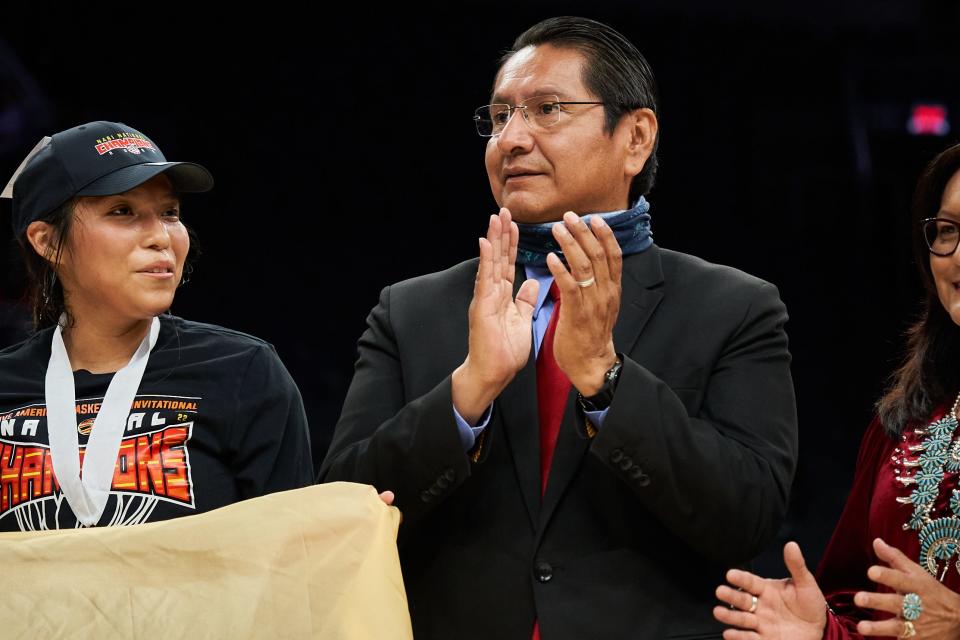EPA targets uranium waste on the Navajo Nation, adding Lukachukai mines to Superfund list
The U.S. Environmental Protection Agency has placed the Lukachukai Mountains Mining District in northeastern Arizona on the federal Superfund National Priorities List, unlocking new funding sources to clean up a site long contaminated by uranium waste.
The area becomes the only Superfund site on the Navajo Nation, part of a list of known sites throughout the United States where historic releases of hazardous substances, pollutants or contaminants pose significant threats to human health and the environment.
The Lukachukai District, among more than 500 abandoned uranium mine sites on the Navajo Nation, is located in the Cove, Round Rock and Lukachukai tribal chapters. Past uranium and vanadium mining in the Lukachukai Mountains created more than 100 piles of mine waste, which are contaminated with radium 226, uranium and other heavy metals.

Former Navajo Nation President Jonathan Nez wrote to the EPA in December 2022 in support of placing the site on the National Priorities List, and the current Navajo administration supports the listing.
Stephen B. Etsitty, executive director of the Navajo Nation Environmental Protection Agency, said placing the district on the Superfund list was a long time coming and historic.
“We’ve been anxiously awaiting this decision,” he said, as well as emphasizing that there are no other sites on the Navajo Nation that are on the listing.
“This is why it's historic,” said Etsitty. “We know the EPA has been providing information to the chapters last year. We appreciate the effort of the U.S. EPA to keep our communities informed, but we always ask them to continue to work with us to do an even better job for transparency.”
New mines: Uranium ore from a mine near the Grand Canyon will hit the road soon, despite opposition
Lukachukai district was an early site for uranium mining
Waste piles in the Lukachukai Mountains continue to pose a threat, and materials have migrated downstream in washes and may have contaminated groundwater. Past ore hauling activities spread contamination along miles of historical ore haul roads, according to the U.S. EPA.
“This is historic for the Navajo communities of Cove, Lukachukai, and Round Rock, and the whole Navajo Nation,” said Cove Chapter President James Benally. “It’s reassuring to know the Superfund designation will expand the remediation of the abandoned uranium mine sites on our sacred mountain. We fully support the NPL listing, on behalf, our grandchildren, and generations to come, and the environment.”
The Navajo EPA has placed the number of abandoned uranium mines on the Navajo Nation at 523, but others believe it to be in the thousands. In the 1940s, uranium was first discovered on the Navajo Nation in the Carrizo Mountains near Cove.
From the late 1940s to the 1980s, Kerr-McGee Corporation mined more than 7 million tons of uranium ore on or near the Navajo Nation. About 32 of these mines are located in the Cove area. In total from 1944 to 1986, nearly 30 million tons of uranum ore was extracted from Navajo under leases with the Navajo Nation.
Uranium production in the northern and western Carrizo Mountains of the Navajo Nation, begun in 1948, peaked in 1955 and 1956 and declined to zero again by 1967.
Many Navajo families live in the Lukachukai Mountains and use the land for livestock grazing, recreation and hunting. It is a sacred area of the Navajo Nation, providing plants for traditional medicinal and ceremonial uses. The mountains provide habitat for several sensitive species, including the federally threatened Mexican spotted owl.
Contaminated areas: Parents want a decision about plans to replace a Navajo school near old uranium mines
Superfund sites funnel more money to clean-up work
The Lukachukai Mountains Mining District was one of five sites added to the National Priorities List this week. Other sites include: Former Exide Technologies Laureldale, Laureldale, Pennsylvania; Acme Steel Coke Plant, Chicago; Exide Baton Rouge in Louisiana; and a fifth site in Des Moines, Iowa.
The Bipartisan Infrastructure Law has supported EPA’s work to clean up NPL sites with a $3.5 billion investment in the Superfund remedial program. The EPA has been able to provide as much funding for site cleanup work in the past two years as it did in the previous five years, officials said.
The National Priorities List includes sites with the nation’s most serious uncontrolled or abandoned releases of contamination. This list serves as the basis for prioritizing EPA Superfund cleanup funding and enforcement actions.
“Updating the National Priorities List is a critical component of EPA's comprehensive approach to protecting human health and the environment from contamination, including in communities overburdened by disproportionate environmental impacts,” said EPA Administrator Michael S. Regan.
“Cleaning up contaminated land and groundwater and returning them for productive use to communities, especially those which have borne the brunt of legacy pollution, is a win for public health and local economies,” he said.
Before the EPA adds a site to the National Priorities List, it must meet EPA’s requirements and be proposed for addition to the list in the Federal Register and subject to a 60-day public comment period.
“We’ve been in support of this,” said Etsitty. “Navajo Nation President Nygren, he’s been much aware of the importance and the historic nature of this decision by the United States Environmental Protection Agency and he is going to be looking forward to the U.S. continuing to fulfill its obligations and its commitments to clean up the legacy of abandoned uranium mines.”
Arlyssa Becenti covers Indigenous affairs for The Arizona Republic and azcentral. Send ideas and tips to arlyssa.becenti@arizonarepublic.com.
Support local journalism. Subscribe to azcentral.com today.
This article originally appeared on Arizona Republic: EPA places Lukachukai mining site to Superfund site for waste cleanup

